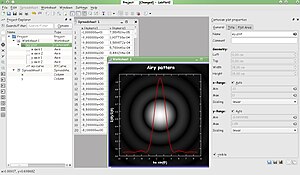LabPlot

Screenshot of LabPlot of 2014
|
|
| Original author(s) | Stefan Gerlach |
|---|---|
| Initial release | 2001 (version 0.1, under the name QPlot) 2003 (version 1.0, renamed to LabPlot) |
| Stable release |
2.3.0 / 23 July 2016
|
| Repository | anongit |
| Written in | C, C++ |
| Operating system | Cross-platform |
| Type | Plotting |
| License | GNU General Public License |
| Website | labplot |
LabPlot is a free software and cross-platform computer program for interactive scientific graphing and data analysis, written for the KDE desktop. It is similar to Origin and is able to import Origin's data files.
LabPlot was initiated by Stefan Gerlach, a scientist and IT administrator at the University of Konstanz. He separately published liborigin, a library for reading OriginLab OPJ project files.
In 2008, developers of LabPlot and SciDAVis (another Origin clone, forked from QtiPlot) "found their project goals to be very similar" and "decided to start a close cooperation" with the aim of merging their code into a common backend, while maintaining "two frontends, one with full KDE4 integration (called LabPlot 2.x) and one with no KDE dependencies (pure Qt so to say) for easier cross-platform use (called SciDAVis)".
It uses the Qt widget set for its graphical interface. It is integrated with the KDE desktop and has drag and drop support with KDE's applications. The handbook is written in KDE and conforms to the Khelpcenter standards. It is scriptable using Qt Script for Applications (QSA). 2D and 3D plots of data can be rendered in a "worksheet", either by directly reading datafiles or from a spreadsheet, which LabPlot supports. It has interfaces to several libraries, including GSL for data analysis, the Qwt3d libraries for 3D plotting using OpenGL, FFTW for fast Fourier transforms and supports exporting to 80 image formats and raw PostScript. Other key features include support for LaTeX and Rich Text labels, data masking, multiple plots in the same worksheet, pie charts, bar charts/histograms, interpolation, data smoothing, peak fitting, nonlinear curve fitting, regression, deconvolution, integral transforms, and others (see developers website listed below for details). The graphs are publication-quality. Interface translated in various languages.
...
Wikipedia
